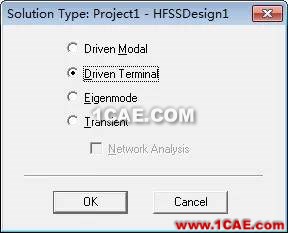HFSS分析求解类型 Solution Type如何选择?,Driven Modal 还是 Driven Terminal?
2016-10-11 by:CAE仿真在线 来源:互联网
在帮助文件中,Driven Modal 和 Driven Terminal 的定义非常相似,如何进行区分呢?
HFSS有四种求解类型,其中Driven Modal和Driven Terminal都是用于有源驱动(需要端口激励)情况。这里重点介绍一下这两个求解器的区别:
— Driven Modal的求解主要是微带线、波导等传输结构,这种求解类型得到的S 参数是基于主模到高次模的各种模式的广义S参数,因此常用于天线和微波器件仿真;
— Driven Terminal的求解主要是终端为多根导体的传输线,比如差分线,这种端口需要定义终端线,求解得到的S参数是基于终端的,因此常用于电路、高速互连等SI设计。

|
Driven Modal 驱动模式 |
For calculating the mode-based S-parameters of passive, high-frequency structures such as microstrips 微带, waveguides波导, and transmission lines 传输线 which are "driven" by a source, and for computing incident plane(入射面) wave scattering 散射. 计算基于s参数的模型,一般天线使用这种模式,但不适合一个端口多个终端的情况,此时需要使用终端驱动。 |
|
Driven Terminal 终端驱动 |
For calculating the terminal-based S-parameters of passive, high-frequency structures with multi-conductor transmission line ports which are "driven" by a source. This solution type results in a terminal-based description in terms of voltages and currents. Some modal data is also available. 用于多导体传输线的端口情况,根据终端电压和电流计算s矩阵 |
|
Eigenmode 本征模 |
For calculating the eigenmodes, or resonances, of a structure. The Eigenmode solver finds the resonant frequencies of the structure and the fields at those resonant frequencies. Eigenmode designs cannot contain design parameters that depend on frequency, for example a frequency-dependent impedance boundary condition. 相当于结构分析的模态分析,本征模用于求解找到天线结构的谐振频率。 |
|
Transient 瞬态 |
For calculating problems in the time domain. It employs a time-domain (“transient”) solver. SelectingTransientenables a radio button forNetwork Analysis. Your choice affects the options for the setup. If you selectNetwork Analysisthe setup includes an Input Signal tabfor the simulation. Typical applications include, but are not limited to: • Simulations with pulsed excitations, such as ultra-wideband antennas, lightning strikes, electro-static discharge; • field visualization employing short-duration excitations; • time-domain reflectometry. 求解随时间变化的电磁问题、电磁场变量 |
1、从help的解释来看,Eigenmode solution主要用于谐振结构,而Driven Modal和Driven Terminal主要用于传输线、波导,包括天线等结构。
但关键是两者的区别是什么呢?
如果需要仿真的结构是多导体结构(如同轴线),可以传播TEM模,存在电压和电流的定义,这样就可以用电压波和电流波来描述该传输线,可以使用Driven Terminal模式。但如果需要仿真的结构是单导体结构如矩形,柱形波导,则沿线电压、电流不再有定义,只能用网络理论中的内向波、外向波描述端口的性质,此时用Driven Modal。 对于微带,传播模式是准TEM模,按help的解释应该用Driven Modal,但在ansoft的full-book对port的解释中又有这样一句:For structures like coupled transmission lines or connectors, which support multiple, quasi-TEM modes of propagation, it is often desirable to compute the Terminal S-Parameters.可见用Driven Terminal还是可以的
总结:
1、driven modal的适用范围很广,不需要设置积分线,而driven terminal要在端口设置积分线
2.如果模型中有类似于偶合传输线求偶合问题的模型一定要用driven terminal求解,
3.driven modal适于其他模型, 但一般tem模式(同轴,微带等)传输的单终端模型一般用driven terminal分析(tem波电压一般由两导体之间电场积分定义,电流为环线磁场的积分,阻抗Zvi=Zpi=Zpv区别于TE TM) 由于其直接对电流电压求解而避免了对整个面上功率的计算从而比较简便.
相关标签搜索:HFSS分析求解类型 Solution Type如何选择?,Driven Modal 还是 Driven Terminal? HFSS电磁分析培训 HFSS培训课程 HFSS技术教程 HFSS无线电仿真 HFSS电磁场仿真 HFSS学习 HFSS视频教程 天线基础知识 HFSS代做 天线代做 Fluent、CFX流体分析 HFSS电磁分析






